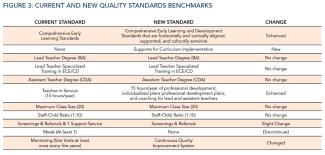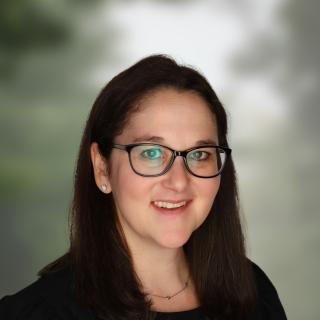
The State of Preschool 2016
Raising the Bar on Quality
May 26, 2017
The State of Preschool 2016 yearbook released this week found more states–43 plus the District of Columbia and Guam–funding public preschool programs, more children enrolled and more quality standards benchmarks met. Since we began surveying states in 2002, continued–albeit, slow–progress has been made.
Since NIEER introduced the Yearbook in 2003, research has continued to inform practice regarding the characteristics of programs and classrooms necessary to provide children with the high quality early learning opportunities shown to make a positive difference in their lives. The most recent research has identified supports to teachers for improving classroom experiences as key. These findings–together with progress among many states in meeting the minimum standards we have applied in the past–prompted NIEER this year to introduce updated quality standards benchmarks to assess state policies supporting public preschool programs.
Current benchmarks were designed to guide states as they developed preschool programs, providing minimum policy standards to support high quality, in conjunction with political will and adequate funding. States meeting all 10 current quality standards benchmarks should be proud of their accomplishments but meeting the benchmarks does not by itself guarantee children receive a high-quality classroom experience.
New quality standards benchmarks raise the bar for quality supports and reflect the importance of more direct supports for process quality–the actual experiences children have within classrooms, primarily through interactions with teachers and peers. Such interactions are significantly linked with children’s development. New benchmarks focus on policies that can foster high-quality interactions, such as professional development and coaching for all teaching staff and continuous improvement quality systems through which teachers receive constructive feedback on their teaching practices. Recent research shows coaching focused on improving interactions with children can both improve teaching practices and ensure high-quality classroom environments. Additional updates focus on the content of classroom instruction, including policies to support curriculum implementation and early learning standards aligned with both other state standards and child assessments. The figure below shows the list of current and new quality standards benchmarks, as well as the changes.

Exactly how are the benchmarks changing?
First, we enhanced the Early Learning and Development Standards (ELDS) benchmark. The previous requirement was for ELDS to be comprehensive, covering multiple areas of development including children’s physical well-being and motor development, social and emotional development, approaches towards learning, language development, and cognition and general knowledge. The new benchmark requires more from states’ ELDS.
To meet the new benchmark, ELDS must be vertically aligned with states’ infant and toddler standards and their K-3 or college and career ready standards. Second, ELDS must be horizontally aligned with child assessments. They must also be supported by the state through means such as ongoing technical assistance or additional resources to support implementation. And ELDS should be culturally sensitive to reflect the diverse backgrounds of children and staff.
For the past few years all programs have met the current ELDS benchmark, this year included. Looking at the new ELDS benchmark, this year, 46 of 59 programs (78%) met the new benchmark.
NIEER also introduced a curriculum supports benchmark requiring states have supports in place to help programs select appropriate curricula and provide supports for curriculum implementation such as training or ongoing technical assistance. It is important to note this new benchmark does not mandate that programs use a specific curriculum, but rather gauges whether curriculum use and decision-making are supported. Research suggests the use of both domain general and domain specific curriculum, when teachers are supported in their implementation, has positive effects on children’s learning and development. Most states already do this, as 47 programs (80%) met this new quality standards benchmark.
NIEER also has eliminated the meals benchmark. While we continue to believe good nutrition is critical for children’s healthy development, whether or not states met this benchmark has been largely determined by if programs operate for a part- or full-day.
Another change substantially raises the bar on requirements for staff professional development. Previously, the benchmark required that lead teachers receive 15 clock hours of professional development per year. We now include assistant teachers, as well as lead teachers. In addition, both lead and assistant teachers must have individualized annual professional development plans and all classrooms must receive coaching or classroom-embedded support. While 49 programs (83%) met the current professional development benchmark, just six programs in four states met the new requirement. We recognize this is a very high bar and hope states will make progress expanding professional development to all teaching staff, given the solid research foundation linking teacher training and mentoring with classroom quality and children’s learning.
The last major change is a shift from program monitoring to a continuous quality improvement system (CQIS). The current benchmark requires all programs to receive a site visit at least once every five years. The new benchmark requires state programs to have a CQIS, which research suggests can improve classroom quality practices in ways that support high-quality learning experiences for children. To meet the new CQIS benchmark, all classrooms must receive annual structured classroom observations on a valid and reliable measure, and the information collected must be used to help teachers improve their practices. At this time, 42 programs (71%) met the current site visits benchmark, with 22 programs (37%) meeting the new CQIS benchmark.
We know poor quality can render preschool programs ineffective at best, or even harmful. We have learned over the past decade that states must do more to support quality beyond providing adequate resources. Policies are needed that focus on active supports for good teachers to provide engaging, intentional and individualized education for every child.
Responding to these concerns, NIEER’s new benchmarks focus on policies that more directly support continuous improvement of teaching. The 2016 Yearbook includes both current and new benchmark scores for each state, recognizing that it takes time for states to revise policies to meet new standards. Scores on new benchmarks clearly demonstrate many states must do much more to ensure high-quality programs.
Dr. Friedman-Krauss, co-author of The State of Preschool 2016, is an Assistant Research Professor at the National Institute for Early Education Research. Dr. Friedman-Krauss holds a Ph.D. in Developmental Psychology from the Steinhardt School of Culture, Education, and Human Development at NYU. While at NYU, Dr. Friedman-Krauss was part of the Secondary Analysis of Variation in Impacts center that was funded by ACF to reanalyze the Head Start Impact Study. She also co-authored NIEER’s ground-breaking State(s) of Head Start report released in December 2016.
The Authors
Allison Friedman-Krauss is an Associate Research Professor at NIEER where she is also the Associate Director for Policy Research and Director of the Infant and Toddler Policy Research Center.
About NIEER
The National Institute for Early Education Research (NIEER) at the Graduate School of Education, Rutgers University, New Brunswick, NJ, conducts and disseminates independent research and analysis to inform early childhood education policy.

